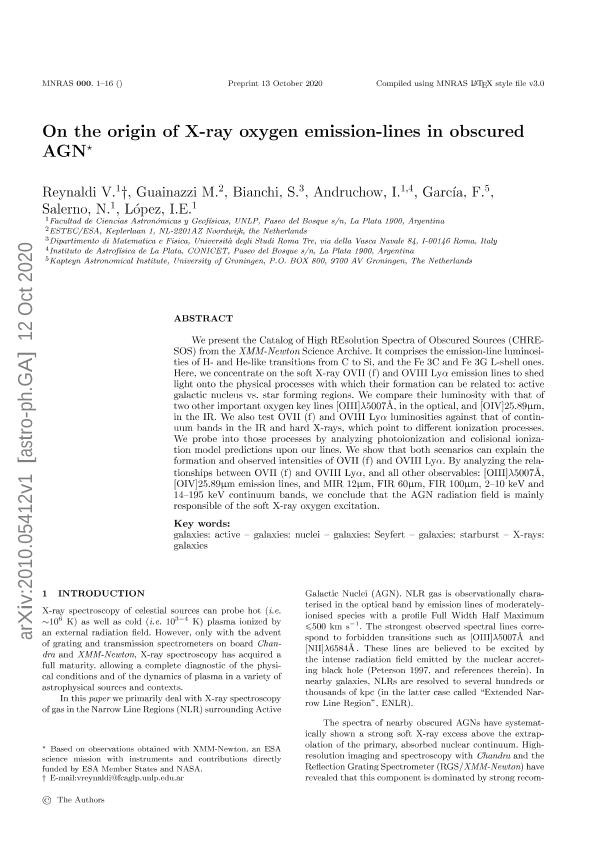Mostrar el registro sencillo del ítem
dc.contributor.author
Reynaldi, María Victoria

dc.contributor.author
Guainazzi, Matteo

dc.contributor.author
Bianchi, S
dc.contributor.author
Andruchow, Ileana

dc.contributor.author
García, Federico

dc.contributor.author
Salerno, N
dc.contributor.author
López, I. E.
dc.date.available
2021-11-26T16:40:20Z
dc.date.issued
2020-12
dc.identifier.citation
Reynaldi, María Victoria; Guainazzi, Matteo; Bianchi, S; Andruchow, Ileana; García, Federico; et al.; On the origin of X-ray oxygen emission lines in obscured AGN; Wiley Blackwell Publishing, Inc; Monthly Notices of the Royal Astronomical Society; 499; 4; 12-2020; 5107-5120
dc.identifier.issn
0035-8711
dc.identifier.uri
http://hdl.handle.net/11336/147529
dc.description.abstract
We present the Catalogue of High Resolution Spectra of Obscured Sources (CHRESOS) from the XMM-Newton Science Archive. It comprises the emission-line luminosities of H- and He-like transitions from C to Si, and the Fe 3C and Fe 3G L-shell ones. Here, we concentrate on the soft X-ray O VII (f) and O VIII Lyα emission lines to shed light on to the physical processes with which their formation can be related to active galactic nucleus (AGN) versus star-forming regions. We compare their luminosity with that of two other important oxygen key lines [O III] λ5007 Å, in the optical, and [O IV] 25.89 μm, in the infrared (IR). We also test O VII (f) and O VIII Lyα luminosities against that of continuum bands in the IR and hard X-rays, which point to different ionization processes. We probe into those processes by analysing photoionization and collisional ionization model predictions upon our lines. We show that both scenarios can explain the formation and observed intensities of O VII (f) and O VIII Lyα. By analysing the relationships between O VII (f) and O VIII Lyα, and all other observables: [O III] λ5007 Å, [O IV] 25.89 μm emission lines, and mid-infrared (MIR) 12 μm, far-infrared (FIR) 60 and 100 μm, 2-10 and 14-195 keV continuum bands, we conclude that the AGN radiation field is mainly responsible of the soft X-ray oxygen excitation.
dc.format
application/pdf
dc.language.iso
eng
dc.publisher
Wiley Blackwell Publishing, Inc

dc.rights
info:eu-repo/semantics/openAccess
dc.rights.uri
https://creativecommons.org/licenses/by-nc-sa/2.5/ar/
dc.subject
galaxies: active
dc.subject
galaxies: nuclei
dc.subject
galaxies: Seyfert
dc.subject
galaxies: starburst
dc.subject.classification
Astronomía

dc.subject.classification
Ciencias Físicas

dc.subject.classification
CIENCIAS NATURALES Y EXACTAS

dc.title
On the origin of X-ray oxygen emission lines in obscured AGN
dc.type
info:eu-repo/semantics/article
dc.type
info:ar-repo/semantics/artículo
dc.type
info:eu-repo/semantics/publishedVersion
dc.date.updated
2021-07-01T15:02:29Z
dc.journal.volume
499
dc.journal.number
4
dc.journal.pagination
5107-5120
dc.journal.pais
Reino Unido

dc.description.fil
Fil: Reynaldi, María Victoria. Consejo Nacional de Investigaciones Científicas y Técnicas. Centro Científico Tecnológico Conicet - La Plata. Instituto de Astrofísica La Plata. Universidad Nacional de La Plata. Facultad de Ciencias Astronómicas y Geofísicas. Instituto de Astrofísica La Plata; Argentina
dc.description.fil
Fil: Guainazzi, Matteo. Agencia Espacial Europea. European Space Research And Technology Centre.; Países Bajos
dc.description.fil
Fil: Bianchi, S. Universita Degli Studi Roma Treviso; Italia
dc.description.fil
Fil: Andruchow, Ileana. Consejo Nacional de Investigaciones Científicas y Técnicas. Centro Científico Tecnológico Conicet - La Plata. Instituto de Astrofísica La Plata. Universidad Nacional de La Plata. Facultad de Ciencias Astronómicas y Geofísicas. Instituto de Astrofísica La Plata; Argentina
dc.description.fil
Fil: García, Federico. Kapteyn Astronomical Institute; Países Bajos
dc.description.fil
Fil: Salerno, N. Universidad Nacional de La Plata. Facultad de Ciencias Astronómicas y Geofísicas; Argentina
dc.description.fil
Fil: López, I. E.. Universidad Nacional de La Plata. Facultad de Ciencias Astronómicas y Geofísicas; Argentina
dc.journal.title
Monthly Notices of the Royal Astronomical Society

dc.relation.alternativeid
info:eu-repo/semantics/altIdentifier/url/https://academic.oup.com/mnras/article/499/4/5107/5928562
dc.relation.alternativeid
info:eu-repo/semantics/altIdentifier/doi/https://doi.org/10.1093/mnras/staa3169
Archivos asociados
